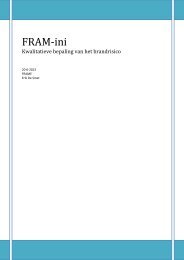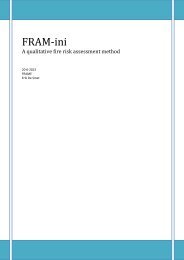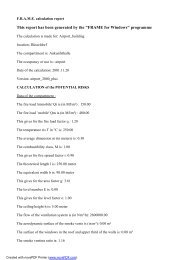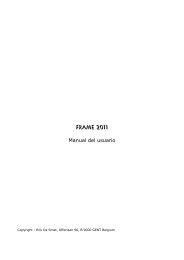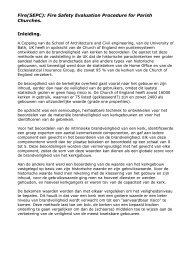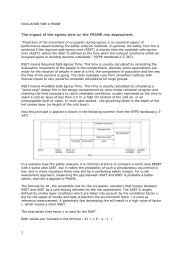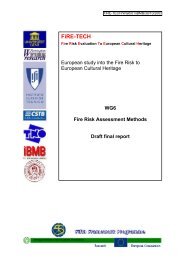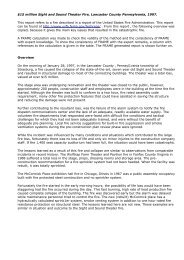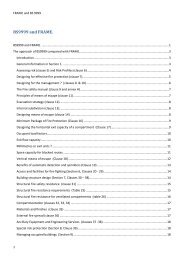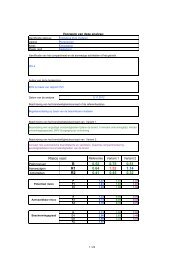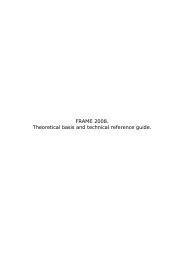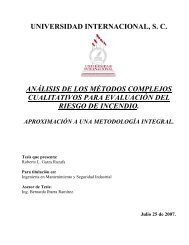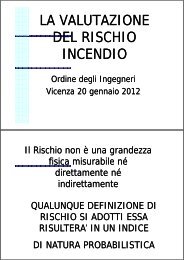FRAME Calculation examples book. - FRAME Fire Risk Assessment ...
FRAME Calculation examples book. - FRAME Fire Risk Assessment ...
FRAME Calculation examples book. - FRAME Fire Risk Assessment ...
Create successful ePaper yourself
Turn your PDF publications into a flip-book with our unique Google optimized e-Paper software.
F.R.A.M.E.<br />
Content factor: 1 M. Euro c=0.00<br />
environment factor r r= 0.30<br />
dependency factor d d= 0.50<br />
Acceptable <strong>Risk</strong>s A= 0.58 A1= 0.28 A2 =0.98<br />
Water supplies adequate W=1.00<br />
Normal protection limited training, nearest<br />
N = 0.90<br />
station at less than 10<br />
min<br />
Special Protection part time fire brigade S= 1.34<br />
<strong>Fire</strong> resistance Structure: 30<br />
F=1.28<br />
Walls: 30<br />
Ceiling:30<br />
Partitions:30<br />
Escape protection sub compartments,<br />
U=1.80<br />
adequate signalisation<br />
Salvage sub compartments Y=1.10<br />
Calculated <strong>Risk</strong>s: R= 2.48 R1= 3.50 R2=1.38<br />
Conclusion:<br />
A catastrophe could be expected.<br />
Notes.<br />
1. The report indicates a capacity of 148 residents. With staff and visitors an occupancy load of<br />
350 persons could be estimated, below the 486 based on code occupant load numbers. A lower<br />
number of occupants would still give an unacceptable high risk level.<br />
2. The smoke detectors in corridors were not accounted for as those are not the critical areas<br />
(the rooms should be considered as critical) .<br />
3. New nursing homes of this type would require sprinkler protection according to NFPA 101.<br />
Adding sprinkler protection would reduce the risk levels to : R=1.10 , R1=1.40 and R2=0.66 .<br />
This means that <strong>FRAME</strong> does not consider adding sprinklers as adequate enough. Additionally<br />
automatic smoke detection would be required to get an acceptable level of safety for the<br />
occupants. This is because of the low mobility of the residents which requires a fast detection<br />
and reaction.<br />
On the other hand, if the 4 wings of the building were properly separated by compartment<br />
walls and fire doors, whereby the number of people at risk would be below 100, a smoke<br />
detection system would provide adequate protection according to <strong>FRAME</strong>.<br />
Case study 15. A clue for arson : Office in Bristol (UK), June 1 st , 1989.<br />
Reference : <strong>Fire</strong> Prevention 232, September 1990<br />
<strong>FRAME</strong> calculation :<br />
Item explanation (sub) factor Value Result<br />
Type of occupancy Bristol computer suite 1989<br />
<strong>Fire</strong> load immobile Qi 300<br />
<strong>Fire</strong> load mobile Qm 600 q=1.42<br />
Temperature rise computers T 100<br />
Average dimension m 0.3<br />
Reaction to fire M 2 i=1.15<br />
Length l 100<br />
Width b 30 g=0.74<br />
Level E 5 e=1.60<br />
Height of room h 4<br />
Ventilation k 0.5 % v=1.02<br />
Access direction Z 3<br />
26



